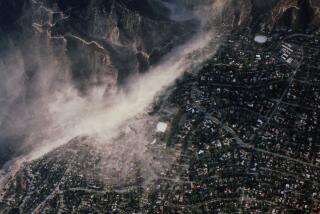These Cloudbursts Had a Silver Lining : The response to last week’s deluge showed what we learned from past natural disasters
It’s now official. Between the funding needed to make repairs from the 1989 Loma Prieta earthquake through projected aid expenditures through 1996, federal taxpayers will have paid about $7 million a day to aid in California’s recovery from natural disasters. That makes the state the nation’s biggest drain on such funds. And no, these figures do not include the past week’s incredible deluge, flooding and mudslides.
Under such circumstances, it is difficult to find a silver lining. But there is some good news, and it is not inconsequential.
It was in 1992 (and within that same span of disasters) that similarly heavy rains dumped 16 inches of water on Woodland Hills. Seven people died, and more than $88 million in damage was reported. The Sepulveda Basin was suddenly transformed into an inland sea, stranding dozens of panicked motorists on the tops of their cars. Desperate rescues had to be made to bring them to safety. It did not happen again.
Precautionary measures began early this time, as Los Angeles police officials closed Burbank Boulevard and Woodley avenue. Once the water level at Sepulveda Dam reached 680 feet, local officials wisely closed the entire basin to traffic at 10 p.m. Monday. By the time that flood levels were reaching the bottom of street traffic signals, there was no possibility of a repeat of stranded motorists, and no possibility of tragedy in the basin.
Also back in 1992, Woodland Hills teen-ager Adam Bischoff drowned when he fell into the storm-swollen Los Angeles River. That prompted city and county officials to launch an educational program at schools that warned of the dangers of the steep, smooth concrete walls of such flood channels. And swift-water rescue teams were patrolling the channels citywide on Tuesday, ready to prevent a repeat drowning.
We can’t prevent natural disasters, but the steps to close the basin and patrol the channels show that we can certainly learn from them.
More to Read
Sign up for Essential California
The most important California stories and recommendations in your inbox every morning.
You may occasionally receive promotional content from the Los Angeles Times.










